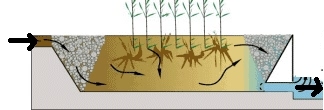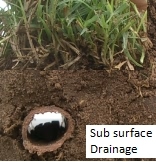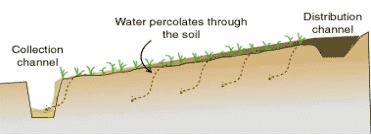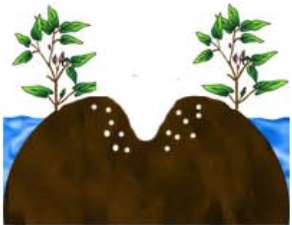सेलाइन (खारा) मिट्टी के सुधार की तकनीक
Accumulation of excess salts in the root zone resulting in a partial or complete loss of soil productivity is a worldwide problem. Soil salinity has caused heavy loss of national wealth in India. Out of 329 million hectares of land in the country, about 175 million ha (53 %) is suffering from degradation.
The extent of this problem area as given by different sources varies from 8.56 M ha to 10.9 M ha. According to Central Soil Salinity Research Institute (CSSRI), Karnal, 1.7 M ha of land is affected by salinity among the 6.7 M ha of salt affected land. World as a whole is losing at least three hectare of arable land every minute by soil salinization.
The problems of soil salinity are most widespread in the arid and semi-arid regions. Soil salinity is also a serious problem in areas where groundwater of high salt content is used for irrigation.
The most serious salinity problems are being faced in the irrigated arid and semi-arid regions of the world and in these regions that irrigation is essential to increase agricultural production to satisfy food requirements.
Development of saline soil
There are several reasons for development of salinity in the soils such as,
- Excessive and uncontrolled irrigation
- Accumulation of salts in the top layer due to evapo-transpiration in arid conditions
- Water logging conditions in perennial river basins/ irrigation sources due to seepage
- Excessive use of chemical fertilizers containing chlorides, sulfates etc.
- Poor drainage conditions.
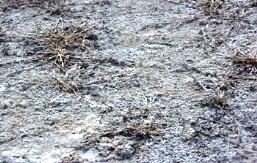 Characteristics of saline soils:
Characteristics of saline soils:
Salinesoils are rich in soluble salts such as sodium, potassium, calcium, magnesium, chloride, sulphate, carbonate, bicorbanate etc. that leads to alkaline pH of soil i.e. 7 to 8.5.
Since, these soils are rich in soluble salts electrical conductivity (EC) of these soil is higher i.e.EC > 4 dSm-1.
Also these soils are having considerable quantity of sodium but not as sodic soil that leads to low exchangeable sodium percentage (ESP) and sodium adsorption ratio (SAR) i.e. ESP < 15 and SAR < 13.
Effect of salinity on crop growth and development
Increasedosmotic pressure of soil solution due to excessive salts retards moisture and nutrient absorption by crops. High concentration of soluble salts produces toxic effect directly to the crops. Microbial activity also be checked and the soil becomes barren.
But these soils are potentially productive soils and their potential can be improved by proper ameliorating techniques.
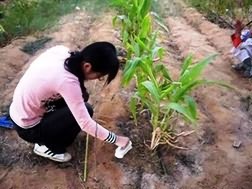 Ameliorating techniques for saline soils
Ameliorating techniques for saline soils
The main objective of amelioration is reducing the quantity of soluble salts from saline soil.The following technologies can be followed to reclaim the saline soil.
1. Scraping
It is removal of the salts that have accumulated on the soil surface mechanically. It has limited success and may temporarily improve crop growth.
2. Leaching
This is the most effective management technique for removing salts from the root zone of soils. Stagnation of fresh water can dissolve the salts in the field. Now this water with dissolved salts can be drained out from the field.
This way salts can be leached from the salt affected field. Leaching should preferably be done when the soil moisture content is low and the groundwater table is deep.
Leaching during the summer months is less effective because large quantities of water are lost by evaporation. If adequate fresh water is not available, lesssalinewater (EC 0.25 dS/m) also can be used.
3. Drainage
Poor drainage condition leads to accumulation of rain water in low lying areas during rainy season. If it is not drained out properly the groundwater table is raised to less than 2 m within 5-10 years and result accumulation of salts due to evaporation from the surface.
In general, the critical depth of water table ranges between 1.5 to 3.0 m to check the salinization. So drainage is necessary to prevent salinization.
4. Irrigation frequency
More frequent irrigations prevent the salt accumulation by keeping the soil at higher soil moisture content. So crops grow in saline soils must be irrigated more frequently.
5. Irrigation method
Sprinkler or drip irrigation is ideal method for irrigating frequently and with small quantity of water at a time. Leaching of soluble salts is also accomplished more efficiently when the water application rates are lower than the infiltration capacity of the soil and such a condition cannot be achieved by flood irrigation methods.
6. Proper use of irrigation water
Salt free or less saline (if salt free water is not available) water only to be used.Moistureshould be kept at optimum field capacity to check the salt accumulation.
7. Management of soil fertility throughproper fertilizer application
Generally saline soils are low in fertility status. Response of nitrogen is better when it is applied with green manures and green leaf manures such as dhaincha. However, excessive fertilization on a highly saline soil is of no value. Uses of acid forming fertilizer such as ammonical and amide form help to drop the pH level of soil.
8. Mulching
Soil salinization is particularly high when the water table is shallow and the salinity of groundwater is high. Mulching can reduce evaporation from the soil surface and encourage downward flow of soil water there by check the accumulation of salts on soil surface.
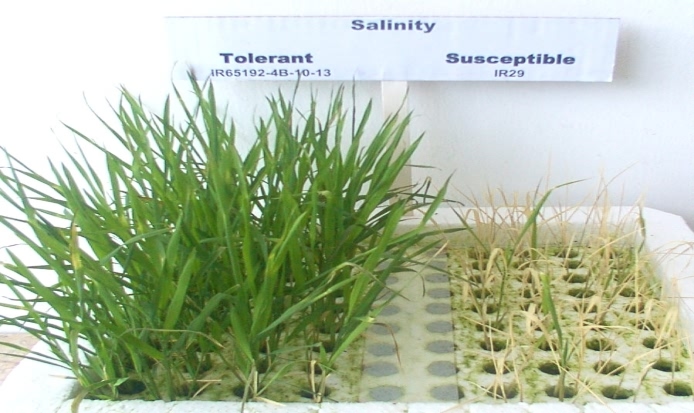
Salts tend to accumulate at the raised portion of soil. So planting or seeding at sides or shoulder of ridges help them to emerge in saline soil.
10. Growing salt tolerant crops
Tolerance and sensitiveness are varies with crops that are given in table 1. Crop tolerance varies with their growing stages as shown in table 2.
Saline tolerant rice varieties that suitable for different states are given in the table 3. Saline tolerant root stocks and varieties are given in table 4.
Table 1
| Highly salt tolerant crops | Barley, sugarcane, sugar beet, oats, sesbania etc., |
| Moderately salt tolerant crops | Wheat, rice, cotton, sorghum, maize, pearl millet, etc., |
| Low salt tolerant crops | Pulses, peas, beans, sesame, radish, sunhemp, white clover, etc., |
| Saline sensitive crops | Tmato, onion, potato, carrot etc., |
Table 2
| Crop | Germination stage | Established stage |
| Barley | Very good | Good |
| Corn (maize) | Good | Poor |
| Wheat | Fairly good | Fair |
| Sugarbeet | Very poor | Good |
| Beans | Very poor | Very poor |
Table 3:
| State | Rice Varieties |
| Andhra Pradesh | MCM 1; MCM 2 |
| Kerala | Pokhali |
| Maharashtra | Kala Rata; Bhura Rata |
| West Bengal | Matla, Hamilton |
| Tamil Nadu | PVR I, Trichy 1 & 2. |
Table 4
| Crops | Rootstocks |
| Citrus (Citrus spp.) | Rangpur lime, Cleopatra mandarin rough lemon, tangelo, sour orange, sweet orange, citrange. |
| Stone fruit (Prunusspp.) | Marianna, Lovell, Shalil& Yunnan |
| Avocado (Perseaamericana) | West Indian & Mexican |
| Grape (Vitisvitifera) | Salt creek and Dogridge |
| Crops | Varieties |
| Grape (Vitisvitifera.) | Perlette andCardinal |
| Berries (Rubusspp.) | Boysenberry, Olallie blackberry & Indian summer raspberry |
| Strawberry (Fragariaspp.) | Lassen & Shasta |
Gypsum – can be an amendment for saline soil?
The application of an amendment such as gypsum may not be essential for desalinization but can hasten the process by maintaining a higher infiltration rate by continuously supplying soluble calcium to the leaching water.
Thus, requirement of gypsum application depends on soil infiltration rate, the electrolytes and calcium level of the irrigation water and soil. So, light textured soils do not require gypsum application whereas heavy soils require gypsum. Gypsum application can reduce the salinity of deeper soil but do not show any effect in surface soils.
Conclusion:
Saline soils are barren but potentially productive soils. All the problematic soil are need to be rectified and made to be productive to ensure the food security of ever growing population. Soluble salts concentration of saline soil can be minimized by the above technique and made into productive.
Tolerance of crops to be improved through salt resistant root stocks, genetic and molecular approach those further helps to get higher yield in saline soils.
Growing of crops on the shoulder of ridges
(note that root portion is safed from zone of salt accumulation)
Authors:
1Thamarai Thuvasan K*, 2K.Jeevika and 3R.Muthukrishnan
1,2&3Assistant Professor, Department of Soil Science & Agricultural Chemisttry
Vanavarayar Institute of Agriculture, Manakkadavu, Pollachi.
*email:

